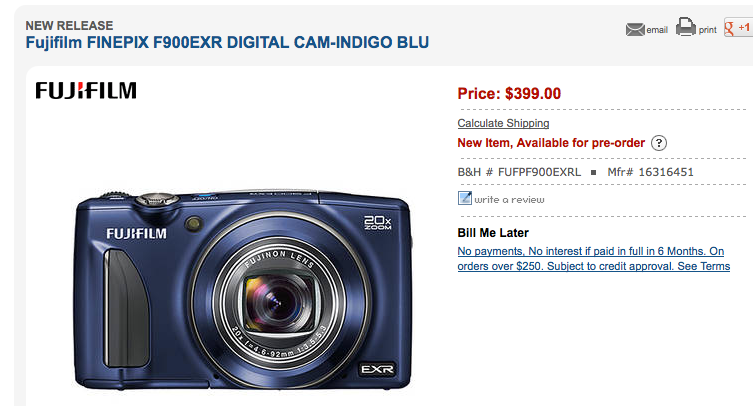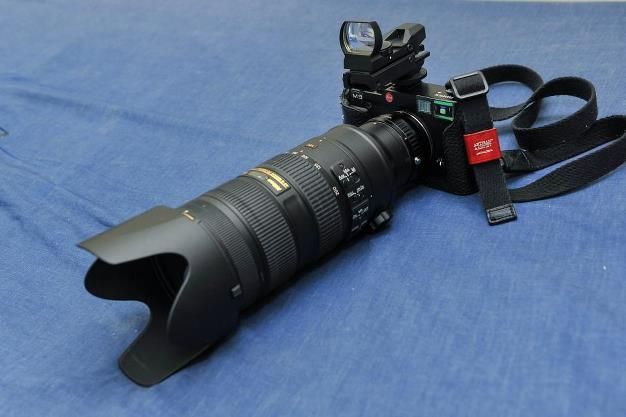5 new Fuji compact cameras released
- F900EXR (specs & price)
- F850EXR (specs & price)
- S6800 (specs & price)
- S4800 (specs & price)
- JX680 (specs & price)
These are the 5 new compact cameras announced by Fujifilm. Here the specs:
FinePix F900EXR
Read the digitalcamerainfo preview
• 16MP ½-inch EXR-CMOS II sensor with Phase Detection and EXR Processor II
• 20x optical zoom (25-500mm*4) with CMOS-shift Image stabilization
• 3.0” LCD screen with wide viewing angle
• EXR-Auto (with auto optimization for 108 different scene permutations)
• Full manual controls
• Intelligent Hybrid AF (World’s Fastest AF of 0.05 seconds*1)
• Start-up time of 1.1 seconds*2
• Interval between shots of 0.5 seconds*2
• RAW shooting (RAW, JPEG, RAW+JPEG image capture modes)
• Wireless Image Transfer to PC, tablets and smartphones
• 11 frames/second*2 (max 5 frames) continuous shooting (at full resolution)
• Advanced Filters
• Motion Panorama 360
• Full HD 1080p Video (60fps)
• Available in black, and indigo blue
• 260 shots*4 per battery charge
FinePix F850EXR
• 16MP ½-inch EXR-CMOS sensor with EXR Processor II
• 20x optical zoom (25-500mm*4) with CMOS-shift Image stabilization
• 3” LCD screen
• EXR-Auto mode (with auto optimisation for 108 different scene permutations)
• Full manual controls
• Fast AF of up to 0.21 seconds*2
• Start-up time of 1.1 seconds*2
• Interval between shots of 0.5 seconds*2
• 9.0 frames/second*2 (max 5 frames) continuous shooting (at full resolution)
• Advanced Filters
• Motion Panorama 360
• Full HD 1080p Video (60fps)
• Eye-Fi Card Compatibility
• Available in black
• 250 shots*2 per battery charge
FinePix S6800
• FUJINON Super zoom Lens (24mm wide-angle to 720mm telephoto lens, f/3.1 to 5.9)
• 16MP 1/2.3” BSI-CMOS sensor
o Autofocus speed of up to 0.3 seconds
o Continuous shooting; 8fps (10frames, full resolution), 60fps 60 frames, image size 1280×960) ,120 fps (60 frames, image size 640×480)
o Start-up time of 1.0 second
o Shooting interval time of 0.5 seconds
• Optical Image Stabilization (Sensor Shift)
• Full HD movie 1080i/60 fps with stereo sound and slow-motion capture at 480fps
• Bright 3.0-inch LCD screen ( 460K-dot)
• Manual exposure control(P/S/A/M modes)
• Super Macro to 0.78”
• Dual zoom control
• Instant zoom and Zoom Bracketing
• 4×AA alkaline batteries with an approximately 320 shot battery life
• Available in black, white, and red
FinePix S4800
• FUJINON Super zoom lens (24mm wide-angle to 720mm telephoto lens, f/3.1 to 5.9)
• 16MP 1/2.3” CCD sensor
• Optical Image Stabilization (Sensor Shift)
• Scene Recognition Auto with 6 pre-set scenes
• Autofocus in 0.3 seconds*1
• HD Movie 720P/30fps with Video Scene Recognition
• 3” LCD monitor (230k dots)
• Manual exposure control (P/S/A/M modes)
• Instant Zoom
• Mini HDMI output
• 4×AA alkaline batteries with an approx. 320 shot battery life
• Available in Black
FinePix JX680
• 5x FUJINON optical zoom (26-130mm*) with Digital Image Stabilization
• 16MP CCD sensor
• 26mm* wide-angle
• 3.0” LCD screen
• Creative Advanced Filters
• Individual shutter 3D
• Motion Panorama
• Easy to use GUI with large buttons
• 720p HD movie recording with dedicated “Movie Recording Button”
• Advanced video editing features
• Super slim and pocket-friendly (just 20mm*2)
• Battery charging via USB cable


